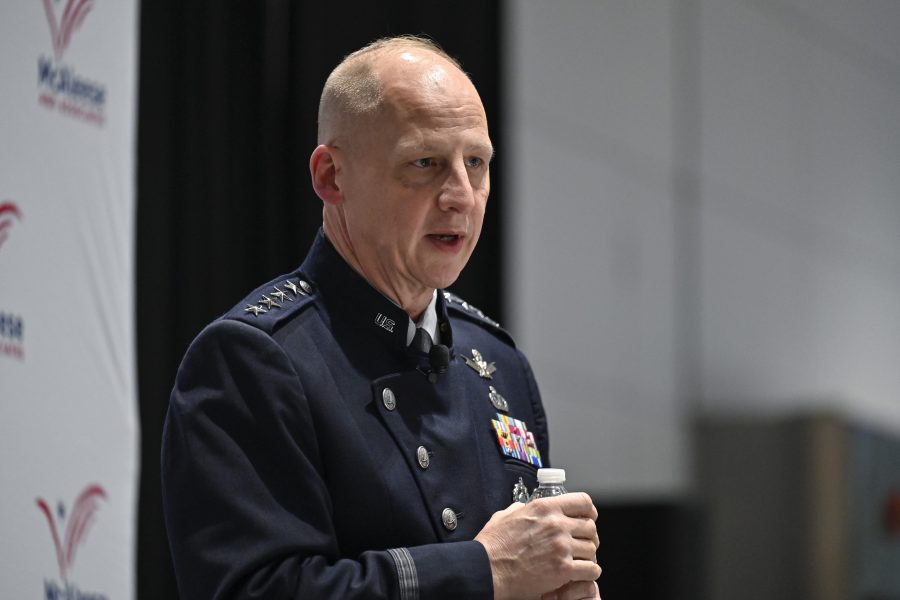Despite the Space Force’s “laser-focused” effort to accelerate an initiative to bolster its GPS constellation, the service’s No. 2 officer said the effort is mostly in the study and analysis phase.
“I don’t think we’ll ever move fast enough,” Vice Chief of Space Operations Gen. Michael A. Guetlein said at the Defense News Conference last week. “There is an enormous amount of attention from the White House on position, navigation and timing (PNT) and how to shore up those signals, looking at alternative capabilities. Is there another way we could be doing this, that’s more resilient, more survival against the threat? I would say we could be doing more in this area.”
One of service’s main efforts in the area is dubbed Resilient GPS, or R-GPS. The idea is to add around 20 small, cost-effective GPS satellites to the existing 31, addressing rising concerns about over-reliance on the existing satellites and the possibility of an attack on them.
The initiative first emerged in February when Space Systems Command began exploring the commercial market for a constellation of GPS satellites, seeking “ways to reduce lifecycle cost and increase the pace of GPS satellite development, production and on-orbit deployment.” In April, the Department of the Air Force revealed it had chosen the program as one of the first to take advantage of its new ‘Quick Start’ authorities.
But the House Appropriations Subcommittee on Defense turned down the service’s request to reprogram $77 million for Resilient GPS in the 2025 budget in June. They cited unclear benefits, questioning whether the additional satellites would better protect against GPS jamming compared to other methods, and noted the program for focusing solely on satellites while overlooking the need for the M-code equipment—an encrypted GPS signal essential for jamming resistance. They also questioned whether the program should have followed the regular budget process.
While details on the R-GPS program’s direction is scarce, experts share lawmakers’ reservations regarding the new initiative.
“Whatever solution the Space Force pursues, it must address the variety of the most likely and most dangerous threats, such as jamming, cyber and potential threats to the on-orbit architecture,” said Charles Galbreath, senior resident fellow at Mitchell Institute for Aerospace Studies. “But if the resilient GPS architecture that they’re putting forward does not address all these concerns, the service may need to rethink their strategy to gain Congressional support.”
The question centers on whether the new system will simply add more of the same GPS satellites or include satellites with different waveforms to better counter jamming. Guetlein noted that the service is currently exploring these areas of concern, with the Space Warfare Analysis Center leading the effort.
“What can we do to shore up the civil signal and the military signal on GPS, to get more resilience during times of crisis—that study is going on right now,” said Guetlein. “We’re looking at, can we proliferate it? Can we disaggregate it? Or is there an alternative, technically, that we should be pursuing? Those studies are ongoing, the discussions are happening in the Pentagon as we speak.”
Guetlein noted that should be GPS be disrupted for even just 15 minutes, the U.S. would face a $1 billion hit to the economy, and that it would “dwarf anything that we’ve seen since COVID.”
“If we lose GPS in this nation, we can’t get crops out of the field, we can’t get goods off the shelf or off the boat, we can’t get ambulances to your house, and you can’t travel,” Guetlein warned.
The vulnerability of GPS could seriously amplify the chaos in a conflict. If the Space Force’s constellations face interference, similar to what China, Russia, and others have demonstrated, it could disrupt U.S. military logistics and navigation on land, sea, and air. This would also hurt the accuracy of GPS-guided munitions, leading to more flights needed to hit targets and putting additional American and coalition aircrews at risk, while also raising the chance of collateral damage.
“We are laser-focused on guaranteeing space capabilities will be there when needed, which means we need more SATCOM, more resilient position navigation and timing, or GPS,” added Guetlein. “We’re waiting on the 2025 budget on the Hill to see what that shakes out.”


